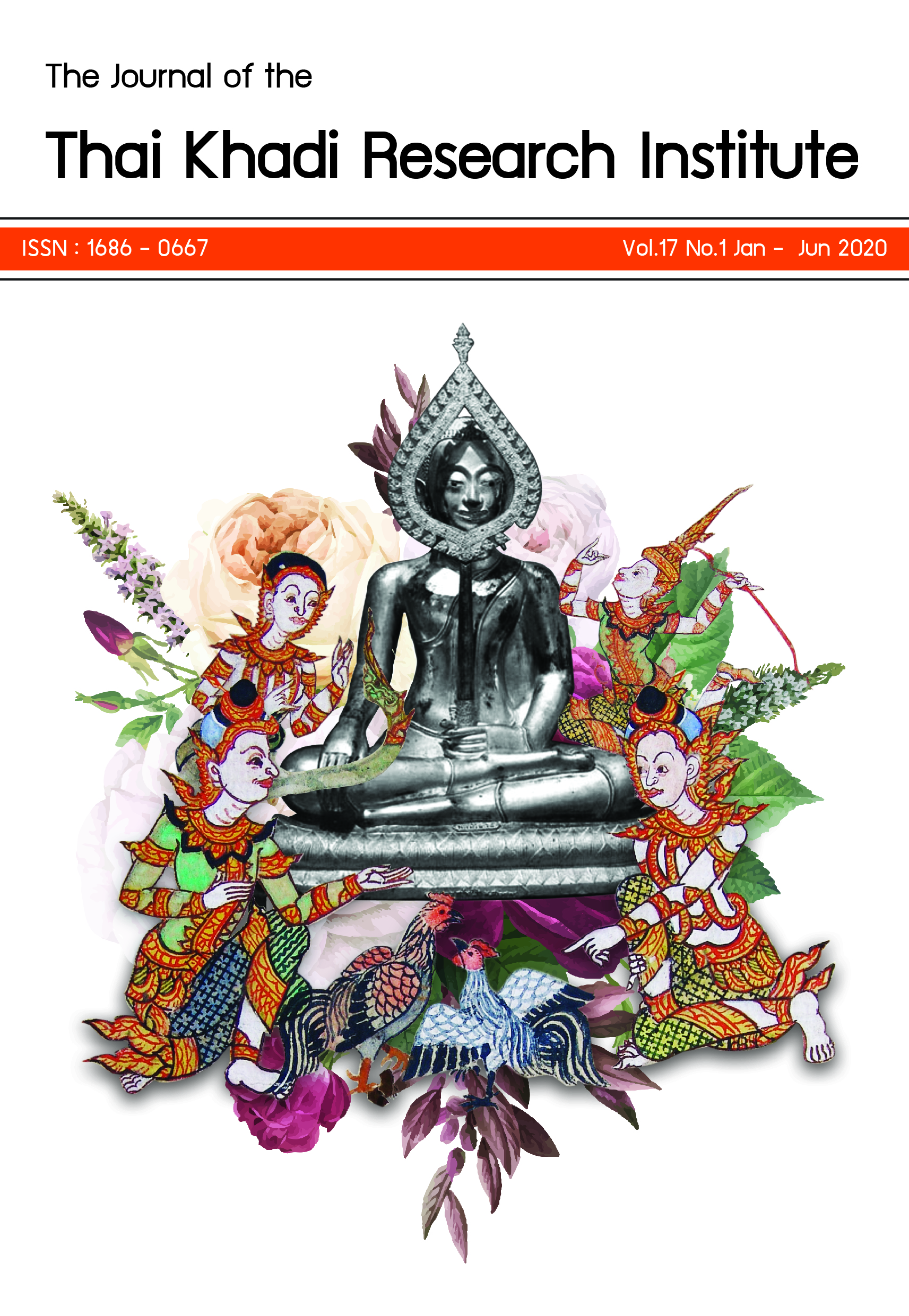พระศรีอาริย์ถือตาลปัตร: ที่มาและรูปแบบจากหลักฐานงานประติมากรรมสมัยรัตนโกสินทร์
Main Article Content
บทคัดย่อ
บทความเรื่องพระศรีอาริย์ถือตาลปัตรนี้เป็นการศึกษารูปพระศรีอาริย์ในกลุ่มประติมากรรมที่มีรูปแบบคล้ายภิกษุถือตาลปัตร โดยประติมากรรมลักษณะดังกล่าวมีการนำไปใช้กับรูปพระมาลัย ทำให้อาจมีความสับสนในการใช้ชื่อเรียกและยังไม่มีข้อสรุปที่ชัดเจน โดยในบทความนี้ได้การศึกษาที่มาจากเอกสาร และคติความเชื่อที่เกี่ยวข้องกับพระศรีอาริย์เพื่อทำการวิเคราะห์ความเป็นไปได้ในการใช้ลักษณะการถือตาลปัตรมาเป็นรูปแบบหนึ่งของรูปพระศรีอาริย์ และทำการสำรวจเก็บข้อมูลประติมากรรมภิกษุถือตาลปัตรในสมัยรัตนโกสินทร์เพื่อทำการวิเคราะห์ทางด้านประวัติศาสตร์ศิลปะ โดยในการศึกษาที่มาของรูปแบบการถือตาลปัตรของพระ ศรีอาริย์น่าจะมีที่มาจากคติการลงมาจุติบนโลกเพื่อบำเพ็ญเพียรในพระชาติต่าง ๆ และพุทธคุณที่กล่าวในพระไตรปิฎกเรื่องการเทศนาอันยิ่งใหญ่ของพระศรีอาริย์จะนำพาไปสู่การหลุดพ้น รวมไปถึงคติความเชื่อเรื่องการลงมาจุติช่วยมนุษย์ และสืบพระศาสนาให้ถึง 5,000 ปี ทั้งนี้จากการสำรวจพบกลุ่มประติมากรรมภิกษุถือตาลปัตรประมาณ 180 องค์ โดยพบกลุ่มที่มีหลักฐานการสร้าง หรือมีจารึกที่ส่วนฐาน จำนวน 17 องค์ สามารถระบุช่วงเวลาการสร้างได้ในสมัยรัตนโกสินทร์ ในรัชกาลที่ 1 จนถึงรัชกาลที่ 8 ในที่นี้ มีจารึกส่วนฐานระบุว่าสร้างรูปพระศรีอาริย์ได้ทั้งหมด 7 องค์ มีเพียงองค์เดียวที่สร้างรูปพระมาลัย ดังนั้นการรับรู้ว่ารูปแบบภิกษุถือตาลปัตรคือพระศรีอาริย์น่าจะเป็นการรับรู้มาแล้วอย่างน้อยในสมัยรัชกาลที่ 1
Downloads
Article Details
ผู้เขียนจะต้องลงนามในแบบฟอร์มรับรองบทความ เพื่อให้คำยืนยันความรับผิดชอบว่า บทความของผู้เขียนนั้นไม่เคยตีพิมพ์ที่ใดมาก่อน พร้อมรับทราบว่า กระบวนการส่งบทความเข้าพิจารณาและตีพิมพ์ในวารสารไทยคดีศึกษานั้น จะไม่มีการเรียกเก็บค่าใช้จ่ายในการดำเนินการ ยกเว้น ในกรณีที่ผู้เขียนขอยกเลิกการตีพิมพ์บทความในวารสารไทยคดีศึกษาไม่ว่าด้วยสาเหตุใด และหลังจากบทความนั้นเข้าสู่กระบวนการพิจารณาของผู้ทรงคุณวุฒิไปแล้ว ผู้เขียนจะต้องรับผิดชอบต่อค่าใช้จ่ายที่เกิดขึ้นในกระบวนการประเมินเป็นจำนวนเงิน 3,000 บาท (สามพันบาทถ้วน)
เอกสารอ้างอิง
Chandavij, N. (1986). Tālapat læ khrư̄ang prakō̜p samanasak [Talipot fan and Assembly Equipment]. Bangkok: Fine Arts Department.
Chulalongkorn, King. (1938). Chotmāihēt phra rāi kit rāi wan phāk sipsī, siphok [Royal Daily Memorandum]. Bangkok: Mahamongkutrajavidyalaya.
Chutchawantipakorn, W. (2000). Phraphuttharūp khūbānkhūmư̄ang [Buddha Images of Thailand]. Bangkok: Thipakorn Publishing.
Damrong Rajanubhub, Somdejkromphraya. (2014). Thīeo tām thāng rotfai [Travel by Train]. Bangkok: Fine Arts Department.
Encyclopedia for Youth. (2007). Sārānukrom Thai samrap yaowachon dōi phra rāt prasong nai phra bāt somdet phračhaoyūhūa lem thī sāmsipsō̜ng [Encyclopedia for Youth]. Bangkok: Saranukromthai.
Kasempholkoon, A. (2009). Tamnān phrasīʻāri nai sangkhom Thai: kānsāng san læ botbāt [Myths of Phra Sri An in Thai Society: Creation and Roles] (Doctor’s thesis, Graduate School, Chulalongkorn University).
Naritsaranuwattiwong, Prince. (1962). Sān somdet lem nưng, nưng čhet [Letter to respond to Prince Narisaranuwattiwong And Krom Phraya Damrong Rajanubhab]. Bangkok: Business Organization of the Office of the Welfare Promotion Commission for Teachers and Educational Personal.
Paramanujitajinorasa, H.R.H. Prince. (2004). Phra pathommasomphōt kathā [Pathomsombodhikatha]. Bangkok: Lianchiang Chongcharoen Publishing.
Plainoi, S. (1985). Tamnān phrachaiwat læ phrakǣo pračham ratchakān [History of Phra Chaiwat and Phra Kaew]. Bangkok: Graduate Maintenance Club.
Princedd Maha Chakri Sirindhorn Anthropology Centre. (2003). Chārưk thī phanang phra ʻubōsot wat Niwēt tham prawat lem thī sō̜ng [Inscription in Ubosot Wat Niwet Thamprawat No.2]. Retrieved June 20, 2019, from https://db.sac.or.th/inscriptions/inscribe/detail/1139.
Rakang, Wat. (1961). Prawat wat rakhang khōsitārām læ prawat somdetphraphuthāčhān (tō phō̜n sī) [History of Wat Rakang and Somdet Phuthachan]. Bangkok: Prasarnmitr Publishing.
Rawin, B. (1999). Phra ʻanākhot wong [Budhha in the Future]. Bangkok: Amarin Printing & Publishing Public.
Saisingha, S. (2008). Ngān chāng samai phranangklao [Techician Arts in The reign of King Rama III]. Bangkok: Matichon Publishing.
Saisingha, S. (2013). Phraphuttharūp nai prathēt Thai: rūpbǣp phathanā kān læ khwām chư̄a khō̜ng Khon Thai [Buddha Images in Thailand: Patterns, Developments and Beliefs]. Bangkok: Faculty of Archeology, Silpakorn University.
Silpanon, D. (2010). Kærō̜i phra mālai [Histoyr of Phra Malai]. Bangkok: Museum Press.
Sudsawad, D. (2012). Phra sī ʻariya mēttrai: nǣokhit khati khwām chư̄a læ rūpbǣp pratimākam [Phra Sri Ariya Mettrai: Concept, belief, and sculptural style]. Prachinburi: The 5th Regional Office of Fine Arts Department, Prachinburi.
Tipitaka. (2003, July 27). Chakkawatti sūt [The story of the Emperor]. Retrieved May 20, 2019, from http://www.84000. org/tipitaka/read/v.php?B=11&A=1189&Z=1702.
Tipitaka. (2003, July 27). Phutpakinka kan [Miscellaneous matters about the Buddha] Retrieved May 20, 2019, from http://www.84000.org/tipitaka/read/byitem.php?book=33.2&item =27&item =1preline=&pagebreak=0.
Tipitaka. (2003, July 27). Thakkhinā wi phangkha sūt [Offering to the Lord Buddha] Retrieved May 20, 2019, from http://www.84000.org/tipitaka/attha/attha.php?b=14&i=706.
Vichitrakranlikit, S. (2006). Kānsưksā chœ̄ng wikhro̜ rư̄ang Phraphutthačhao nai ʻanākhot khō̜ng sangkhom Thai sưksā chapho̜ kō̜ranī phra sī ʻariya mēttrai nai phra phut sātsanā mahā thērawāt [An Analytical Study of the Thai People’s Attitude towards The Future Buddha: A case Study of Phra Sri Ariyamettrai Buddha in Theravada Buddhism] (Master’s thesis, Graduate School, Mahachulalongkornrajavidyalaya University).
Wijitwatakarn, W. (1971). Prawat wat khēmāphiratārām (Phim khrang thī sām) [History of Wat Khemapirataram (3rd ed.)]. Thonburi: Krugthai Publishing.


